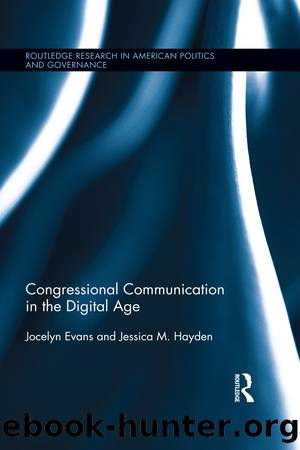Congressional Communication in the Digital Age by Jocelyn Evans & Jessica M. Hayden

Author:Jocelyn Evans & Jessica M. Hayden [Evans, Jocelyn & Hayden, Jessica M.]
Language: eng
Format: epub
Tags: Media & Internet, Political Science, Political Process, American Government, General
ISBN: 9781351754347
Google: Rk0rDwAAQBAJ
Goodreads: 35637357
Publisher: Routledge
Published: 2017-07-06T00:00:00+00:00
By contrast, more than half of member websites provide instructions for setting up a meeting (58.3 percent). The findings indicate that members representing poorer districts are more likely to provide directions for setting up a meeting. Moving from the 90th percentile (the wealthiest and most educated districts) of our socioeconomic character to the 10th percentile (the poorest and least educated districts) of socioeconomic character decreases the likelihood that the member website will provide directions for setting up meetings by 18.29 percent. For district diversity, a member representing a district with only 10 percent minority population is 28.44 percent more likely to provide directions for setting up a meeting than a member with a district with 100 percent minority population. The analysis also suggests that a nonwhite member is about twice as likely (Exp. β = 2.066) to provide directions for setting up a meeting on the office website than a white member. Finally, electorally marginal members attempt to be more accessible by providing directions on their websites for setting up a meeting. A member with a 50 percent vote return is about 22 percent more likely (Exp. β =.980) to offer these directions than a member with 100 percent vote return.
Together, these results indicate that a member who is likely to provide meeting directions on his or her website is nonwhite, with a lower electoral vote return, and comes from a relatively wealthier and better educated district with fewer black and Hispanic constituents. Some aspects of these findings are confounding, but overall they suggest that members are demonstrating multiple motivations on website design simultaneously: a cognizance that poorer constituents will not likely visit the Washington, DC, office, as well as a desire on the part of nonwhite members to be more accessible on and offline, regardless of the racial diversity in the district.
Table 4.5 Frequency Statistics for Categorical Dependent Measures of Accessibility
Download
This site does not store any files on its server. We only index and link to content provided by other sites. Please contact the content providers to delete copyright contents if any and email us, we'll remove relevant links or contents immediately.
The Secret History by Donna Tartt(18865)
The Social Justice Warrior Handbook by Lisa De Pasquale(12143)
Thirteen Reasons Why by Jay Asher(8801)
This Is How You Lose Her by Junot Diaz(6804)
Weapons of Math Destruction by Cathy O'Neil(6152)
Zero to One by Peter Thiel(5693)
Beartown by Fredrik Backman(5609)
The Myth of the Strong Leader by Archie Brown(5429)
The Fire Next Time by James Baldwin(5253)
How Democracies Die by Steven Levitsky & Daniel Ziblatt(5134)
Promise Me, Dad by Joe Biden(5090)
Stone's Rules by Roger Stone(5029)
A Higher Loyalty: Truth, Lies, and Leadership by James Comey(4851)
100 Deadly Skills by Clint Emerson(4845)
Rise and Kill First by Ronen Bergman(4706)
Secrecy World by Jake Bernstein(4653)
The David Icke Guide to the Global Conspiracy (and how to end it) by David Icke(4629)
The Farm by Tom Rob Smith(4442)
The Doomsday Machine by Daniel Ellsberg(4420)
